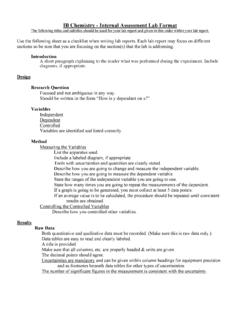Transcription of IB Chemistry: Guide to a Successful Internal Assessment ...
1 IB chemistry : Guide to a Successful Internal Assessment (IA). Be sure to read pages 177-178 in Baby Blue for IA hints. The Internal Assessment write-up should be between 6 and 12 pages long. Investigations exceeding this length will be penalized in the communication criterion as lacking in conciseness. The following outline is suggested for your IA, however, you may adjust in any way you choose. You do not need a title page. Diploma Candidate Number Please put this at the top of each page of your investigation. Do not place your name anywhere on this document. Investigation Title Identifies the topic of your investigation Research Question Clearly and concisely state your research question. Introduction Set the context for your investigation by discussing background information you have found, through your research, regarding what is already known about the topic of your investigation. You may describe alternate methods of gathering data that you discovered during your research and explain why you have chosen the method you will use.
2 Prediction Predict what you think the outcome of your investigation will be. Method - This is your procedure. This must be written with great detail. See below. Analysis See below. Evaluation See below. Citation Bibliography- Use APA Format The following information provides detailed guidance for your IA. The bold categories represent the criteria that are being evaluated and the rubrics incorporated into this document are the grading rubrics used by IB. to evaluate your IA. Before submitting your document, you should read all of the included rubrics and evaluate your IA against the rubric. Criterion: Personal Engagement This criterion assesses the extent to which the student engages with the exploration and makes it their own. Personal engagement may be recognized in different attributes and skills. These could include addressing personal interests or showing evidence of independent thinking, creativity or initiative in the designing, implementation or presentation of the investigation.
3 If your exploration involves a method that can easily be found with an internet search, your work is too simplistic. You might start with a method found through a search, but you must change the investigation to study a variable that is unique and your interest in this variable is described with mild enthusiasm. Criterion: Exploration This criterion assesses the extent to which the student establishes the scientific context for the work, states a clear and focused research question and uses concepts and techniques appropriate to the Diploma Program level. Where appropriate, this criterion also assesses awareness of safety, environmental, and ethical considerations. Methodology (Procedure): In great detail, outline the steps of your procedure in chronological order. Your methods of controlling variables should be very apparent in your procedural steps. If the control of certain variables is not practically possible, some effort should be made to monitor or control the variable(s) in a limited way.
4 It will be important to discuss your inability to control a variable in your evaluation. You must have 5 manipulations (variations) of your independent variable and you should run 3 trials for each manipulation. If you will be graphing your data, you must have at least 5 data points. If you are determining a specific value such as density you should have an initial trial and then as many repeated trials as necessary until consistent results are obtained (usually 5 or more trials). Include safety precautions and clean-up/disposal procedures. Research all chemicals and indicate all safety and disposal precautions. If there is danger of burning skin, indicate how to avoid this such as stating you should use beaker tongs to remove a hot beaker. At a minimum, indicate that goggles and an apron must be worn. Be very specific about the equipment used. Always name the piece of equipment to be used and indicate what size should be used as well.
5 For example: use a graduated cylinder to measure mL of water. Once you're done, read through the lab and make sure you can visualize each step as you read it. Do not use the first person I , we , etc. when writing the steps of your procedure. Criterion: Analysis In this section you will record all qualitative as well as quantitative data you collected during your experiment. Qualitative data could include things such as a description of an odor if present, changes in color or solubility, gas production, heat released or absorbed, and so on. While conducting the lab you should record all of your observations, measurements, or any other data you collect. For any measurements, be sure to include uncertainties and units. Data should be organized in tables whenever possible. The following recommendations should be considered when creating data tables: Recording Raw Data Data is collected independently. Data is primarily quantitative (numerical).
6 Data must include qualitative observations. (This may provide inspiration in the conclusion and especially the evaluation later.). Raw data should be recorded in suitable format(s) as described below. Table organization Must have a title Column headings should include the name of the variable, its associated metric unit and measurement uncertainty if it is the same for all measures in the column or row. The estimated digit in recorded measurements should match the decimal position of the measuring tool's uncertainty Column & row headers identical to graph axes labels (if table is source of graph data). Uses specific terms (ie. NaCl instead of salt; volume instead of amount; length instead of size). Do not split tables between pages Cells contain only one value Tables show grid lines Table numbers Uncertainty in column headings after units. Absolute uncertainties expressed to 1 sig fig. Align decimals All values in a column must end at the same decimal place Mean/average contains one more digit than significant figures in values Table units Units in column headings, not in cells No parentheses Use SI units - according to IB.
7 Variable that is measured or recorded is clearly stated ( in the column heading in a table). Units for every variable. Uncertainty of measurements based on significant digits in the column headings. The same level of precision (number of decimal places) is used for all the items of a variable. You will also carry out all processing of your data necessary to draw a conclusion to your research question. The work for calculations must be shown. Include one example for ALL calculations and ALL results in a clear and concise manner using headings to describe your calculations. Brief explanations should be used to create a flow in calculations. Be meticulous and label EVERYTHING! You must show the propagation of uncertainties here. Be sure to calculate a percent uncertainty and an absolute uncertainty. Also you must calculate a % error if there is an accepted value with which you may compare your results. If it is appropriate, display data in the form of a graph.
8 A second data table with a title should be created to show ALL calculated results. Criterion: Evaluation This criterion assesses the extent to which the student's report provides evidence of evaluation of the investigation and the results with regard to the research question and the accepted scientific context. The evaluation criterion is allocated six marks and focuses on describing and justifying a conclusion, identifying weaknesses in the procedure and suggesting improvements to the investigation. Describing and Justifying Your Conclusion A common error is for students to want to get their investigation 'over and done with' at this point and not spend enough time and effort on this section. Although you are nearly at the finishing line, it is important to keep up with your hard work in order to archive the best possible grade for your investigation. To be awarded a high mark in this section, you should aim to write a conclusion that is fully justified (explains how the data in the analysis section supports your conclusion).
9 Trends in the data that you identified in the analysis section should now be explained using your scientific knowledge. This should involve referring back to your research question and background research in the exploration section of the investigation. Does your data answer the research question? You must draw a conclusion that clearly relates to your research question. Indicate if your conclusion supports your original thinking on the topic. If it does not, a consideration of why it does not will lead into an evaluation of the limitations of the method and suggestions as to how the method and approach could be adjusted to generate data that could help draw a firmer conclusion. For example, data collected might have such great variability that no reasonable conclusion can be drawn. You must justify your conclusion by comparing your result to an accepted scientific context or value. If a percentage error was calculated, you should comment on that percentage error.
10 Discuss the precision and accuracy of your measurements in terms of their limitations on your data and the role they played as a source of error. Commenting on your percent error and comparing your percent error to your percent uncertainty is required and will help support your discussion of precision and accuracy. Compare your percent error to your percent uncertainty (random error). Percent uncertainty indicates how far your experimental values are allowed to be from the accepted value due to the limitations of your measuring tools. If your percent error is greater than your percent uncertainty, this indicates that there are flaws in your methods (systematic error). that are causing your experimental density to be further away from the accepted value. Further justification of your conclusion is required through the discussion of whether systematic errors or random errors were encountered. The direction of systematic errors and their impact on your conclusion must be discussed.








